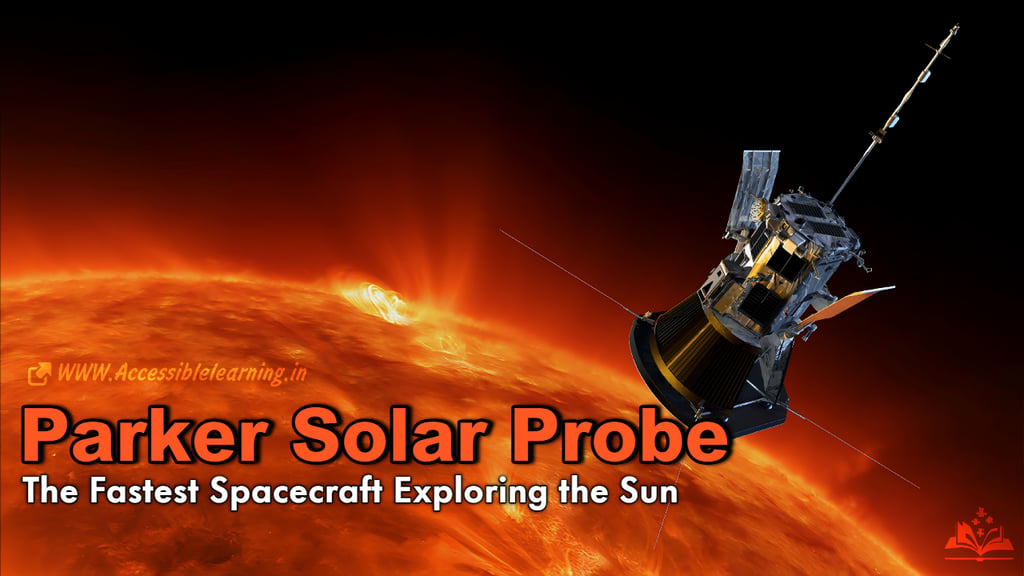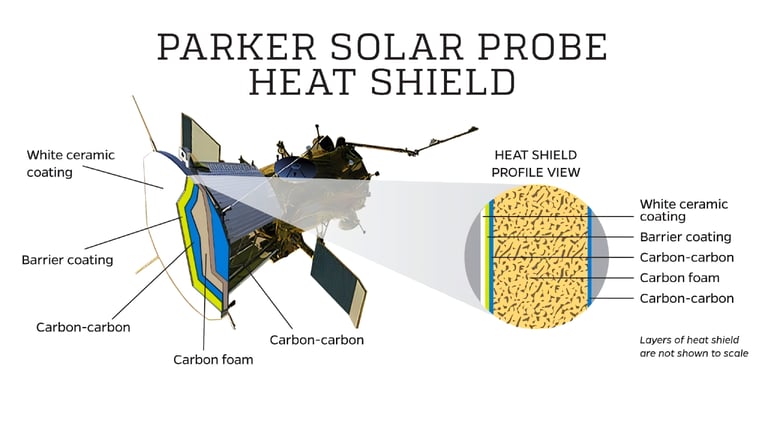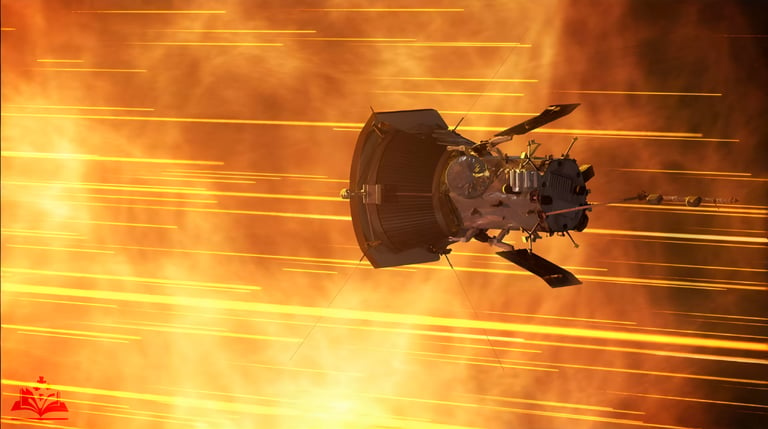
The Science Behind Parker Solar Probe: Instruments, Data, and Future Missions
The Parker Solar Probe is a groundbreaking NASA mission designed to explore the Sun’s outer corona and unravel the mysteries of solar winds, magnetic fields, and space weather. Launched in 2018, this high-speed spacecraft is the closest man-made object to the Sun, providing unprecedented insights into solar activity that impacts Earth and the solar system. Discover its cutting-edge technology, mission objectives, and major scientific breakthroughs in this in-depth article.
SPACE MISSIONEDUCATION/KNOWLEDGESPACE/TECHISRO/NASA
Sachin K Chaurasiya
3/25/20256 min read


The Parker Solar Probe is one of NASA’s most ambitious space missions, designed to explore the outer corona of the Sun and unlock the mysteries of our star. Launched on August 12, 2018, this groundbreaking spacecraft is helping scientists understand the Sun's atmosphere, solar winds, and space weather, which impact Earth and the entire solar system. Named after astrophysicist Dr. Eugene Parker, who first proposed the existence of the solar wind, the probe is the first NASA mission named after a living scientist.
Mission Objectives
The Parker Solar Probe was developed with a primary mission to study the Sun’s outer corona and gather crucial data on solar activity. The mission's key goals include:
Understanding the heating mechanism of the corona: The Sun’s outer atmosphere is hotter than its surface, a mystery that has baffled scientists for decades.
Deciphering the acceleration of solar wind: The high-speed solar wind influences space weather and can disrupt satellite communications and power grids on Earth.
Exploring solar energetic particles: These particles travel at near-light speed and pose risks to astronauts and space technology.
Investigating the structure and dynamics of magnetic fields in the solar corona.
Providing insights into space weather prediction Better understanding the Sun’s activity helps predict solar storms that may affect Earth’s technological infrastructure.
Cutting-Edge Technology Behind Parker Solar Probe
The Parker Solar Probe is the fastest human-made object in history, reaching speeds of up to 430,000 miles per hour (700,000 km/h). To survive the Sun’s extreme heat, it employs innovative technologies, such as:
Heat Shield (Thermal Protection System, TPS)
The spacecraft is equipped with a 4.5-inch-thick (11.4 cm) carbon-composite heat shield, capable of withstanding temperatures exceeding 2,500°F (1,377°C) while keeping the instruments inside at room temperature.
Autonomous Systems for Navigation
Due to the Sun’s intense radiation, the Parker Solar Probe operates using an advanced autonomous system that helps it adjust its orientation to protect itself in real time.
Solar Array Cooling System
Since the probe relies on solar panels for energy, a sophisticated cooling system ensures that the panels remain functional despite the Sun’s harsh environment.
Scientific Instruments
The spacecraft carries four primary instrument suites designed to study various aspects of the Sun:
FIELDS: Measures electric and magnetic fields in the solar atmosphere.
WISPR (Wide-Field Imager for Parker Solar Probe): Captures images of the solar corona and solar wind structures.
SWEAP (Solar Wind Electrons Alphas and Protons): Analyzes solar wind particles and their properties.
ISʘIS (Integrated Science Investigation of the Sun): Detects and studies energetic particles.


Journey and Closest Approach
The Parker Solar Probe follows a unique heliocentric orbit, gradually bringing it closer to the Sun over seven Venus flybys. By 2025, it will make its closest approach at just 3.8 million miles (6.2 million km) from the Sun’s surface, much closer than Mercury’s orbit. To put this into perspective, if Earth and the Sun were a meter apart, the Parker Solar Probe would be only four centimeters away from the Sun at its closest approach.
Major Discoveries and Achievements
Since its launch, the Parker Solar Probe has already made groundbreaking discoveries, such as:
Solar wind turbulence and switchbacks: The probe detected sudden reversals in the Sun’s magnetic field, called switchbacks, which provide insight into solar wind dynamics.
Unexpected dust-free zone: Scientists found that near the Sun, interplanetary dust particles are vaporized by intense solar radiation, creating a “clean zone."
Magnetic field fluctuations: The mission has revealed complex and dynamic magnetic field interactions, helping scientists refine space weather predictions.
Evidence of plasma waves and energy transfer: The probe has observed unique plasma wave interactions, giving new insights into how energy moves through the Sun’s outer layers.
Closer look at solar flares and coronal mass ejections (CMEs): Parker has provided data on how these massive energy bursts originate and spread through space.
Fastest human-made object: Achieved speeds of 430,000 mph (700,000 km/h), breaking all previous space speed records.
First spacecraft to enter the Sun’s corona: In 2021, Parker made history by flying through the Sun’s upper atmosphere, gathering data directly from the source.
Real-time solar wind data for space weather forecasting: Data from Parker is helping improve models predicting solar storms that could impact Earth’s technology.
Why the Parker Solar Probe Matters
Understanding the Sun is crucial for predicting space weather, which impacts Earth’s communication systems, power grids, and satellites. By studying the Sun’s magnetic fields, solar winds, and energetic particles, the Parker Solar Probe is revolutionizing our knowledge of heliophysics and helping to protect modern technology from solar storms.
Additionally, this mission is paving the way for future interstellar exploration by helping scientists understand how stars influence their planetary systems. The discoveries made by Parker Solar Probe could also aid in the study of exoplanetary atmospheres and the habitability of other worlds.
Future of Solar Exploration
The Parker Solar Probe is paving the way for future space missions that will explore the Sun in even greater detail. Scientists hope to use its findings to develop better space weather forecasting models, ensuring the safety of astronauts, satellites, and power infrastructure on Earth.
NASA and other space agencies are already considering follow-up missions to complement Parker’s findings, including the European Space Agency’s Solar Orbiter, which is designed to work in tandem with Parker to provide a more comprehensive understanding of the Sun.


FAQs
What is the Parker Solar Probe?
The Parker Solar Probe is a NASA spacecraft designed to study the Sun's outer corona, solar wind, and magnetic fields. It is the first mission to "touch" the Sun, providing unprecedented insights into solar activity.
Why is the Parker Solar Probe important?
This mission helps scientists understand the Sun’s behavior, including how solar winds and energy affect Earth. Its findings improve space weather forecasting, protecting satellites, astronauts, and power grids from solar storms.
How close will the Parker Solar Probe get to the Sun?
By 2025, the probe will reach just 3.8 million miles (6.2 million km) from the Sun’s surface—far closer than Mercury’s orbit. It will experience temperatures over 2,500°F (1,377°C) while maintaining internal instruments at room temperature.
What are some key achievements of the mission?
Detected solar wind switchbacks, revealing unexpected turbulence in solar winds.
Discovered a dust-free zone near the Sun, where solar radiation vaporizes interplanetary dust.
Observed plasma waves and energetic particles, deepening our understanding of solar energy transfer.
Provided real-time space weather data, improving forecasting models for Earth.
What technologies help Parker survive extreme heat?
The probe uses a 4.5-inch-thick carbon-composite heat shield (Thermal Protection System) that reflects intense solar radiation while keeping instruments safe. It also has autonomous navigation and a cooling system to regulate its solar panels.
How fast is the Parker Solar Probe?
The Parker Solar Probe is the fastest human-made object, reaching speeds of up to 430,000 mph (700,000 km/h)—fast enough to travel from New York to Tokyo in less than a minute.
How does the probe collect data?
It carries four scientific instruments to study solar winds, magnetic fields, and plasma particles:
FIELDS: Measures electric and magnetic fields.
WISPR: Captures images of solar wind and coronal structures.
SWEAP: Analyzes solar wind particles.
ISʘIS: Studies high-energy solar particles.
How does the Parker Solar Probe compare to other solar missions?
Unlike Solar Orbiter (ESA) and other past missions, Parker flies directly into the Sun’s corona, making it the closest spacecraft ever to the Sun.
How long will the mission last?
The Parker Solar Probe is expected to complete its primary mission by 2025, but it may continue sending valuable data beyond that period.
What impact will Parker’s discoveries have on future space exploration?
By improving our understanding of the Sun, this mission helps protect space missions, astronauts, and satellites. It also contributes to the study of stellar physics, interstellar travel, and exoplanet habitability.
The Parker Solar Probe is a historic mission that is bringing us closer to understanding the Sun like never before. By venturing into the Sun’s outer corona, this spacecraft is reshaping our knowledge of solar physics and unlocking secrets that could benefit humanity for generations to come. As it continues its journey, the probe will keep delivering valuable insights into the very heart of our solar system, proving that human curiosity knows no bounds.
The mission is a testament to human ingenuity and scientific ambition, and its discoveries will continue to influence space research, technology, and our understanding of the universe for years to come.
Subscribe To Our Newsletter
All © Copyright reserved by Accessible-Learning Hub
| Terms & Conditions
Knowledge is power. Learn with Us. 📚


